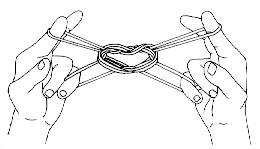This figure was recently obtained by Will Wirt on one of his many worldwide string figure collecting adventures. The figure can be made by placing one end of the loop about the neck or holding the string loop with your teeth.

ĎA Fly,í which goes by the native name Buli, is a string release trick that appears in a film about aboriginal string figures. Many years ago Honor Maude transcribed methods from the film and published them in our Bulletin. But no illustration of Buli is given because itís a trick (the figure dissolves at the end, leaving nothing more than a cluster of hanging loops). In the final stages a finger, which represents the fly, is inserted into the figure. As the mouth releases its loops and the left hand is jerked away, the fly slips free of the strings, thus eluding capture.

When the left half of a string figure is not a reflection of the right half, the design is said to be asymmetric. Asymmetric designs result when the right hand and left hand perform different moves at least once during the weaving process. Asymmetric string figures are often the most realistic. Here's a fine example from Hawaii.

Not all string figures are displayed on the hands -- some are laid on a flat surface and arranged. Here's an arranged figure from Japan. A soft thick string is best since it tends to hold its shape when released.

This realistic pair of Eskimo string figures first appeared in Kathleen Haddon's book "Artists in String." By altering the extension of the final design, a 'Heart' is formed.

Not all string figures are extended fully so that the strings are taut. Here's an animated string figure that features hanging loops. The loops represent a girl's pigtails.
